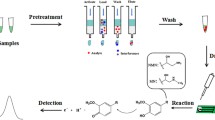Summary
Thirteen phaeochromocytomas were found over five and a half years from 2,834 patient requests for tumour screens. HMMA (VMA) was the usual screening test requested. Free catecholamines were reported when specifically requested by clinicians and where the HMMA level was >40 μmol/24 hr. HMMA and urinary free catecholamines were estimated using HPLC with electrochemical detection in acidified 24 hr collections. Noradrenaline was elevated in all thirteen, nine had raised adrenaline and two had raised levels of all three catecholamines. Urinary free catecholamines are the most appropriate analyte package in our circumstances for the diagnosis of phaeochromocytoma. HMMA if used alone could lead to false negative diagnoses but it has a role in minimising false negatives where urinary catecholamine results are normal.
Similar content being viewed by others
References
Kuska, J., Kokot, F., Drab, M., Drobisz, M. Frequency of incidence of particular etiological forms of arterial hypertension based on 5155 cases analysis. Kardiol. Pol. 1988; 31: 38–47.
Ross, E. J., Griffith, D. N. W. The clinical presentation of phaeochromocytoma. Q. J. Med. 1989; 266: 485–496.
Plouin, P. F., Duclos, J. M., Menard, J., Comoy, E., Bohuon, C., Alexandre, J. M. Biochemical tests for diagnosis of phaeochromocytoma: urinary versus plasma determinations. Br. Med. J. 1981; 282: 853–854.
Duncan, M. W., Compton, P., Lazarus, L., Smythe, G. A. Measurement of noradrenaline and 3,4-dihydroxyphenylglycol in urine and plasma for the diagnosis of pheochromocytoma. N. Engl. J. Med. 1988; 319: 136–142.
Graham, P. E., Smythe, G. A., Edwards, G. A., Lazarus, L. Laboratory diagnosis of phaeochromocytoma: which analytes should we measure? Ann. Clin. Biochem. 1993; 30: 129–134.
Bravo, E. L., Tarazi, R. C., Gifford, R.W., Stewart, B. H. Circulating and urinary catecholamines in pheochromocytoma: diagnostic and pathophysiologic implications. N. Engl. J. Med. 1979; 301: 682–686.
FitzGibbon, M., FitzGerald, R. J., Tormey, W. P., O’Meara, A., Kenny, D. Reference values forurinary HMMA, HVA, noradrenaline, adrenaline, and dopamine excretion in children using random urine samples and HPLC with electrochemical detection. Ann. Clin. Biochem. 1992; 29: 400–404.
Davidson, D. F., FitzPatrick, J. A simple, optimised and rapid assay for urinary free catecholamines by HPLC with electrochemical detection. Ann. Clin. Biochem. 1985; 22: 297–303.
O’Neill, G., Tormey, W. P., Farrell, M. A., FitzGerald, R. J., Finucane, J. Phaeochromocytoma and lethal lactic acidaemia. Ir. Med. J. 1993; 86: 221.
Tormey, W. P., FitzGerald, R. F. Lack of uniformity in the clinical approach to the interpretation of urinary catecholamines and their metabolites. Ir. J. Med. Sci. 1995; 164:
Moyer, T. P., Jiang, N-S., Tyce, G. M., Sheps, S. G. Analysis for urinary catecholamines by liquid chromatography with amperometric detection: methodology and clinical interpretation of results. Clin. Chem. 1979; 25: 256–263.
Davidson, D. F. Urinary catecholamine assay by HPLC: in vitro interference by some drugs. Ann. Clin. Biochem. 1988; 25: 583–584.
Plouin P-F., Degoulet, P., Tugaye, A., Ducrocq, M-B., Menard, J. Le depistage du pheochromocytome: chez quels hypertendus?: etude semiologique chez 2585 hypertendus dont 11 ayant un pheochromocytome. Nouv. Presse. Med. 1981; 10: 869–872.
Sutton, M. st, Sheps, S. G., Lie, J. I. Prevalence of clinically unsuspected pheochromocytoma: review of a 50 year autopsy series. Mayo Clinic Proc. 1981; 56: 354–360.
Sardesai, S. H., Mourant, A. J., Sivathandon, Y., Farrow, R. Phaeochromocytoma and catecholamine induced cardiomyopathy presenting as heart failure. Br. Heart J. 1990; 63: 234–237.
Page, L. B., Raker, J. W., Berberich, F. R. Pheochromocytoma with predominant epinephrine secretion. Am. J. Med. 1969; 47: 648–652.
Engelman, K., Zeis, R., Waldmann, R., Mason, D. T., Sjoerdsma, A. M. Mechanism of orthostatic hypotension in pheochromocytoma. Circulation 1968; Suppl 6: 71–72.
Proye, C., Fossati, P., Fontaine, P., et al. Dopamine-secreting pheochromocytoma: an unrecognised entity? Classification of pheochromocytomas according to their type of secretion. Surgery 1986; 100: 1154–1161.
van Vliet, P. D., Burchell, H. B., Titus, J. L. Focal myocarditis associated with pheochromocytoma. N. Engl. J. Med. 1966; 274: 1102–1108.
Krane, N. K. Clinically unsuspected pheochromocytomas. Arch Intern. Med. 1986; 146:54–7.
Sheps, S.G., Jiang, N-S., Klee, G.G. Diagnostic evaluation of phaeochromocytoma. Endocrinol. Metab. Clin. North Am. 1988; 17: 397–414.
Sinclair, D., Shenkin, A., Lorimer, A. R. Normal catecholamine production in a patient with a paroxysmally secreting phaeochromocytoma. Ann. Clin. Biochem. 1991; 28: 417–419.
Sisson, J. C., Frager, M. S., Valk, T. W. et al. Scintigraphic localisation of phaeochromocytoma. N. Engl. J. Med. 1981; 305: 12–17.
Neumann, H. P. H., Berger, D. P., Sigmund, G., Blum, U., Schmidt, D., Parmer, R. J., Volk, B., Kirste, G. Pheochromocytomas, multiple endocrine neoplasia type 2, and von Hipple-Lindau disease. N. Engl. J. Med. 1993; 329: 1531–8.
Russell, C. R., Kennedy, T. L., Kennedy, A. L., Hadden, D. R., Atkinson, A. B. Phaeochromocytoma in Northern Ireland. Ir. J. Med. Sci. 1994; 163:250.
McMillan M. Identification of hydroxytyramine in a chromaffin tumour. Lancet 1956; ii: 284.
Tippett, P. A., McEwan, A. J., Ackery, D. M. A reevaluation of dopamine excretion in phaeochromocytoma. Clin. Endocrinol. 1986; 25: 401–410.
O’Meara, A., Tormey, W., FitzGerald, R. J., FitzGibbon, M., Kenny, D. Interpretation of random urinary catecholamines and their metabolites in neuroblastoma. Acta Paed. 1994; 83: 88–92.
O’Connor, D. T., Deftos, L. J. Secretion of chromogranin A by peptide-producing endocrine neoplasms. N. Engl. J. Med. 1986; 314: 1145–1151.
Adrian, T., Terenghi, G., Brown, M., Allen, J., Bacarese-Hamilton, A., Polak, J., Bloom, S. Neuropeptide Y in pheochromocytomas and ganglioneuroblastomas. Lancet 1983; ii: 540–45.
Weinkove, C. Measurement of catecholamines and their metabolites in urine. ACP Broadsheet No 127. J. Clin. Pathol. 1991; 44: 269–275.
Yoshioka, M., Aso, C., Amano, J., Tamura, Z., Sugi, M., Kuroda, M. Preparation of monoclonal antibodies to vanilmandelic acid and homovanillic acid. Biogenic Amines 1987; 4: 229–235.
Author information
Authors and Affiliations
Rights and permissions
About this article
Cite this article
Tormey, W.P., FitzGerald, R.J. Phaeochromocytoma — A laboratory experience. I.J.M.S. 164, 142–145 (1995). https://doi.org/10.1007/BF02973282
Issue Date:
DOI: https://doi.org/10.1007/BF02973282




